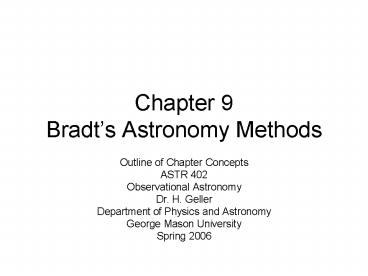Chapter 9 Bradt PowerPoint PPT Presentation
Title: Chapter 9 Bradt
1
Chapter 9Bradts Astronomy Methods
- Outline of Chapter Concepts
- ASTR 402
- Observational Astronomy
- Dr. H. Geller
- Department of Physics and Astronomy
- George Mason University
- Spring 2006
2
Concepts Covered in Chapter 9
- Overriding Concept of Information Content of
Radiation - Luminosities of Objects
- Determination of Masses
- Determination of Temperatures
- Determination of Distances and Sizes
3
Luminosity
- Measure of Luminosity
- At a particular wavelength
- Summed over all wavelengths
- Units
- Watts
- Joules per second
4
Luminosity
- Energy flux density (W/m2)
- If radiation is emitted isotropically
- L F 4pr2
- Measurements are of F
- If distance combined with F you get L
- Understand differences between terms
- Brightness or intensity (observed flux density at
Earth) - Specific intensity (directional spectral energy
flux density) - Surface Brightness (power radiated from unit area
of surface per unit solid angle in a given
direction, bandwidth and frequency)
5
Determination of Masses
- Application of Keplers Third Law of Planetary
Motion - Alternatively
- Apply Newtons Second Law of Motion, and
- Apply Newtons Law of Universal Gravitational
Attraction
6
Determination of Masses
- Mass of spiral galaxy
- Using velocities (Doppler) of stars in spiral
arms - Determination of period of revolution about the
center of the galaxy - Resultant mass of galaxy within the orbit of the
stars observed - Complications due to disk of galaxy
- Spiral galaxy masses not explained by luminous
matter only - Leads to existence of dark matter
7
Determination of Masses
- Clusters of galaxies
- Application of Virial Theorem
- twice the total kinetic energy of all the
particles pllus the sum of the potential energies
equals zero - Applies to gravitationally bound system of
discrete objects in stable equilibrium - Virial mass of a cluster is greater than the
visible mass - Dark matter on a larger scale size
8
Determination of Temperatures
- Thermal and non-thermal radiation
- Kinetic temperature
- Maxwell-Boltzmann distribution
- Color temperature
- Ultraviolet, blue and visible
- Effective temperature
- Stefan-Boltzmann Law
- Excitation temperature
- Boltzmann formula
9
Determination of Temperatures
- Ionization temperature
- Ratio of He I to He II
- Saha equation
10
Determination of Distances
11
(No Transcript)
12
(No Transcript)
PowerShow.com is a leading presentation sharing website. It has millions of presentations already uploaded and available with 1,000s more being uploaded by its users every day. Whatever your area of interest, here you’ll be able to find and view presentations you’ll love and possibly download. And, best of all, it is completely free and easy to use.
You might even have a presentation you’d like to share with others. If so, just upload it to PowerShow.com. We’ll convert it to an HTML5 slideshow that includes all the media types you’ve already added: audio, video, music, pictures, animations and transition effects. Then you can share it with your target audience as well as PowerShow.com’s millions of monthly visitors. And, again, it’s all free.
About the Developers
PowerShow.com is brought to you by CrystalGraphics, the award-winning developer and market-leading publisher of rich-media enhancement products for presentations. Our product offerings include millions of PowerPoint templates, diagrams, animated 3D characters and more.

